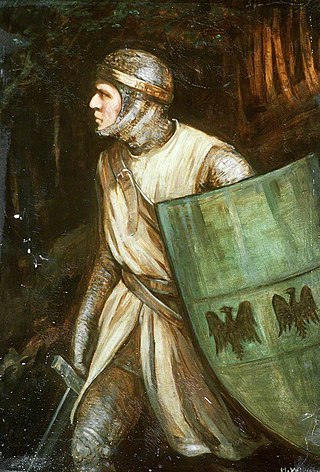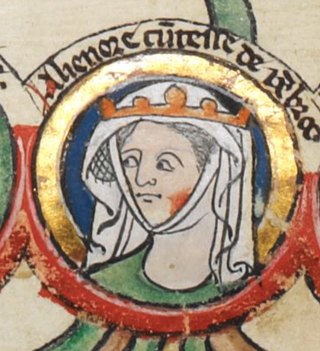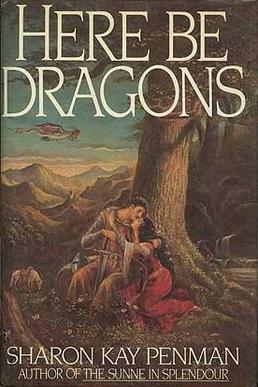
Llywelyn ap Gruffudd, Llywelyn II, also known as Llywelyn the Last, was the native Prince of Wales from 1258 until his death at Cilmeri in 1282. Llywelyn was the son of Gruffydd ap Llywelyn Fawr and grandson of Llywelyn the Great, and he was one of the last native and independent princes of Wales before its conquest by Edward I of England and English rule in Wales that followed, until Owain Glyndŵr held the title during the Welsh Revolt of 1400–1415.

Llywelyn ab Iorwerth, also known as Llywelyn the Great, was a medieval Welsh ruler. He succeeded his uncle, Dafydd ab Owain Gwynedd, as King of Gwynedd in 1195. By a combination of war and diplomacy he dominated Wales for 45 years.

Owain ap Gruffudd was King of Gwynedd, North Wales, from 1137 until his death in 1170, succeeding his father Gruffudd ap Cynan. He was called Owain the Great and the first to be styled "Prince of Wales", and the "Prince of the Welsh". He is considered to be the most successful of all the North Welsh princes prior to his grandson, Llywelyn the Great. He became known as Owain Gwynedd to distinguish him from the contemporary king of Powys Wenwynwyn, Owain ap Gruffydd ap Maredudd, who became known as Owain Cyfeiliog.

Sharon Kay Penman was an American historical novelist, published in the UK as Sharon Penman. She was best known for the Welsh Princes trilogy and the Plantagenet series. In addition, she wrote four medieval mysteries, the first of which, The Queen's Man, was a finalist in 1996 for the Best First Mystery Edgar Award.

Eleanor de Montfort, Princess of Wales and Lady of Snowdon was an English noble and Welsh Princess. She was the daughter of Simon de Montfort, 6th Earl of Leicester King of England and Eleanor of England. She was also the second woman who can be shown to have used the title Princess of Wales.

The Kingdom of Gwynedd was a Welsh kingdom and a Roman Empire successor state that emerged in sub-Roman Britain in the 5th century during the Anglo-Saxon settlement of Britain.

Eleanor of England was the youngest child of John, King of England and Isabella of Angoulême.

The Treaty of Aberconwy was signed on the 10th of November 1277, the treaty was by King Edward I of England and Llewelyn the Last, Prince of Wales, following Edward’s invasion of Llewelyn’s territories earlier that year. The treaty granted peace between the two but also essentially guaranteed that Welsh self-rule would end upon Llewelyn's death and represented the completion of the first stage of the Conquest of Wales by Edward I.
Llywelyn, Llewelyn or Llewellyn is a name of Welsh language origins. See Llywelyn (name) for the name's etymology, history and other details.

Joan, Lady of Wales and Lady of Snowdon, also known by her Welsh name often written as Siwan was the illegitimate daughter of King John of England, and was the wife of Llywelyn the Great, Prince of Wales, effective ruler of all of Wales. Joan or Siwan in Welsh has been referred to as both "Lady of Wales" and "Princess of Wales".

Here Be Dragons is a historical novel written by Sharon Kay Penman and published in 1985. The novel is the first in a trilogy known as the Welsh Princes series set in medieval England, Wales and France that feature the Plantagenet kings.
Perfeddwlad or Y Berfeddwlad was an historic name for the territories in Wales lying between the River Conwy and the River Dee. comprising the cantrefi of Rhos, Rhufoniog, Dyffryn Clwyd and Tegeingl. Perfeddwlad thus was also known as the Four Cantrefs.

Madog II was a Prince of Powys Fadog from 1269 to 1277. He supported the Prince of Wales, Llywelyn ap Gruffudd, who had married the daughter of Simon de Montfort, 6th Earl of Leicester.

The Royal House of Dinefwr was a cadet branch of the Royal House of Gwynedd, founded by King Cadell ap Rhodri, son of Rhodri the Great. Their ancestor, Cunedda Wledig, born in late Roman Britain, was a Sub-Roman warlord who founded the Kingdom of Gwynedd during the 5th century, following the Anglo-Saxon settlement of Britain. As Celtic Britons, the House of Dinefwr was ruling before the Norman conquest, having to fight with their neighbors such as the Celtics, Anglo-Saxons and Vikings, before struggling with the Normans afterwards. Many members of this family were influential in Welsh history, such as Hywel Dda, who codified Welsh law under his rule, and achieved the important title of King of the Britons, or Lord Rhys, Prince of Wales, who rebelled against Richard the Lionheart, and became one of the most powerful Welsh leaders of the Middle ages.
This article is about the particular significance of the century 1201–1300 to Wales and its people.

Wales in the High Middle Ages covers the 11th to 13th centuries in Welsh history. Beginning shortly before the Norman invasion of the 1060s and ending with the Conquest of Wales by Edward I between 1278 and 1283, it was a period of significant political, cultural and social change for the country.
Edward I of England has been portrayed in popular culture a number of times.

The history of Gwynedd in the High Middle Ages is a period in the History of Wales spanning the 11th through the 13th centuries. Gwynedd, located in the north of Wales, eventually became the most dominant of Welsh polities during this period. Contact with continental courts allowed for Gwynedd to transition from a petty kingdom into an increasingly sophisticated principality of seasoned courtiers capable of high level deplomacy and representation; not only with the Angevine kings, but also the king of France and the Papal See. Distinctive achievements in Gwynedd include further development of Medieval Welsh literature, particularly poets known as the Beirdd y Tywysogion associated with the court of Gwynedd; the reformation of bardic schools; and the continued development of Cyfraith Hywel. All three of these further contributed to the development of a Welsh national identity in the face of Anglo-Norman encroachment of Wales.

Devil's Brood is a historical novel written by Sharon Kay Penman, published in 2008, and is the third volume in her Plantagenet series, preceded by When Christ and His Saints Slept and Time and Chance, and followed by Lionheart (2011).

The conquest of Wales by Edward I took place between 1277 and 1283. It is sometimes referred to as the Edwardian conquest of Wales, to distinguish it from the earlier Norman conquest of Wales. In two campaigns, in 1277 and 1282–83, respectively, Edward I of England first greatly reduced the territory of Llywelyn ap Gruffudd, and then completely overran it, as well as the other remaining Welsh principalities.















